
Wind Power
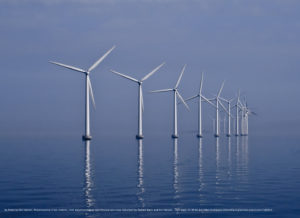
Welcome to Wind Power: The Energy Efficiency Podcast – episode 9, the podcast that brings you a mix of energy efficiency news, products and tips all year round. We’re interested in profiling people and products involved in promoting energy efficiency habits, products and information, so please do get in touch if you have something to contribute.
But before we get on with our advertised features, this week the Guardian reported that architects and engineers are calling for a ban on glass buildings. Glass buildings become extremely hot in the sun and use lots of energy to cool down. This carbon-emitting energy requirement makes no sense in a climate emergency.
In theory using glass to let in light and create heat is a good thing, but when it’s managed properly. Solar gain is an important element of passivhaus design, where it is understood and carefully managed to prevent occupants overheating. Many corporate and commercial glass buildings are designed just for looks. In these heat can build up to unbearable levels without heavy duty air conditioning. As we looked at in our feature on passive cooling, energy used to cool buildings has doubled in the last few years. Buildings can still benefit from solar gain in winter with smaller windows. Natural ventilation can make a huge difference but this can be the short straw in a polluted and noisy area.
Some steps are being taken. Mayor of New York Bill de Blasio has banned excessive use of glass and steel. This is a bit of a climbdown from the ban he spoke of originally. Sadiq Khan, mayor of London, has ruled out a ban. This is surprising given how forward-looking the London Plans have been on the benefits of green technologies (we looked at this last week in the green roofs feature). The new London Plan, coming into force next spring, requires an assessment to be made of a building’s lifetime energy use. It’s hard to see how a standard glass building would come out well of this assessment.
In the Guardian article Martin Fahey, head of sustainability at Mitsubishi Electric, referred to the importance of keeping air conditioning equipment in good working order. Maintenance of equipment has come up repeatedly in keeping energy efficiency at optimum. Fahey hopes that commercial customers will want to do the right thing if only for the sake of their image.

Some hi-tech glass can become opaque in hot weather. Others can generate electricity, such Deloitte’s Edge building in Amsterdam’s Zuidas business district. It uses intelligent design to cut its energy requirement by 70% on a similar building. On three sides it has smaller, opening windows, and one face is glass. It’s been awarded the world’s highest BREEAM rating (Building Research Establishment Environmental Assessment Method) This isn’t a magic bullet however as the specialist glass is nigh on impossible to recycle.
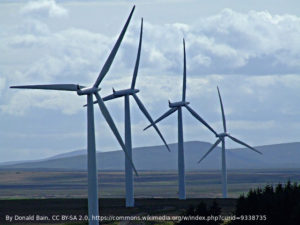 WIND POWER
WIND POWER
It’s a rainy day today and demand on the grid is higher than I’ve seen it for a while. We’re using no coal or oil. Natural gas is providing almost half our power, via CCGT. Renewables are providing about 27% of our power and wind is contributing 10% of that. What is wind power?
As the NES website says, wind power ain’t new. It’s been pushing boats along and powering windmills for thousands of years. It’s magic, actually. Well, no it’s not but as the wind turns the blades which turn a shaft, a generator converts that kinetic energy into electrical energy. That’s where the magic happens. The electricity is then converted into the right voltage for the local network and exported to the grid. A gentle breeze is enough to turn the blades, but faster winds generate more electricity. If it gets too windy wind turbines will shut down to avoid suffering damage. From an individual wind turbine on a house to giant wind farms out at sea, the mechanics are the same. One standard onshore wind turbine can provide enough electricity to power 1,500 homes a year.
Obviously wind turbines are carefully located to pick up maximum and consistent wind. Hilltop and coastal spots are good, which is why Cornwall and Scotland are such popular locations. British turbines produce wind up to 80% of the time at up to 50% efficiency. Because they produce most electricity in the windiest weather, they’re producing well when power is most needed. This makes for a reliable source of renewable power.
Capacity is growing in the UK. Last year wind generated 15% of the UK’s power. There are nearly 10,000 wind turbines here which together produce enough power for nearly 15 million homes. There are around 27 million households in the UK.
Building wind farms
We’ve all heard the arguments that the construction of wind farms is very damaging for the local environment. Does that view hold up? We’re discounting here the visual impact as minding about that is a luxury we can’t afford at the moment. Habitat loss however is a real consideration. Bat and bird deaths increase around wind turbines, with bats suffering worse than birds. this can be mitigated by careful siting of the turbines. Data is still being gathered and the overall impact on wildlife is as yet unclear. It’s worth mentioning that climate change is worse for wildlife.
Noise can be an issue for those living within about a mile of a wind turbine. It can affect birds and animals nesting near turbines.
Wind is a less environmentally damaging way of generating power than acquiring fossil fuels. According to wikipedia wind turbines have the lowest global warming potential per unit of electricity generated compared to other renewable power sources. Purely in the production of energy then (as opposed to making the machinery), wind power uses no water and has negligible emissions. Building the components does create emissions, in some cases higher than that of building a gas-powered station, due to the concrete required for the foundations. In less windy areas more back-up is required, needing either battery storage systems or fossil fuel plants. The bringing on- and off-stream of these other power sources can be power hungry. Magnets used in some wind turbines us neodymium. Extracting this rare earth element is polluting and research is underway to reduce or eliminate the need for neodymium. Turbine manufacturer Enercon doesn’t use permanent magnets for its direct drive turbines to avoid the need for rare-earth mining.
Measuring the impact
Measuring the impact of wind farms can be approached from many angles. The ground clearing and disturbance needed for a wind farm is less than for coal mines and coal-fired plants. In the UK many ideal wind farm sites are covered in blanket bog. Construction will disturb this crucial habitat. The action of the wind turbines can cause localised drying of the peat. When dry, peat releases its carbon. Livestock quite like wind turbines. They graze right up to the foundations, stand in the shade and use them as scratching posts! An article in SciTech Daily says this:
“The direct climate impacts of wind power are instant, while the benefits of reduced emissions accumulate slowly. If your perspective is the next 10 years, wind power actually has — in some respects — more climate impact than coal or gas. If your perspective is the next thousand years, then wind power has enormously less climatic impact than coal or gas.”
Offshore
What about offshore wind turbines? 15 new offshore wind farms were completed in 2018, with the UK and Germany in the lead, particularly the UK. Yesterday Prince Charles opened Scotland’s largest offshore wind farm, Beatrice. Located off Wick, the farm can power 450,000 homes. For comparison, the world’s largest offshore wind farm, off the cost of Cumbria, can power 600,000 homes.
Of course there are concerns about the impact on marine life and commercial fisheries. Sound-sensitive marine mammals are of particular concern. Offshore wind farms need bigger blades and turbines to cope with strong sea winds (which create more electricity), and they must be robust. It’s very expensive to fix turbines, wherever they are. Better undersea transmission routes mean offshore wind farms can be sited away from objectors and obstacles. Whales can migrate undisturbed, valuable beachfront properties don’t need to look at them, and shipping can move unimpeded. All of this has been a big deal in the USA which is only now moving forward with offshore wind. Wired has an interesting article on the subject, link in the show notes.
Domestic wind power
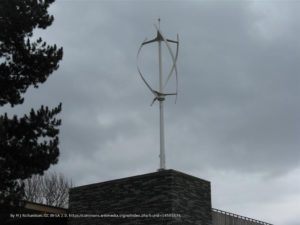
Domestic wind turbines can be fitted to individual homes. It’s extremely expensive. The Energy Saving Trust quotes between £10 and £30,000. The turbine attaches to a pole or to the house. House-mounted are cheaper, but less efficient. In high winds they can vibrate and damage the structure of the building. As with solar panels, the inverter might need replacing at some point, at a current cost of £1-2000. The installation should last 20 years. Off-grid systems will need batteries replaced every 6-10 years. As we looked at last week for off-grid solar consumers, batteries are a very expensive option.
A typical house usually requires a home wind turbine with a 5 kW generating capacity to meet all its energy requirements. This is unusually large for a domestic environment. To be worth having though a wind turbine does need to be a minimum sensible size and in a good windy space. Usually that will be tall and away from trees and buildings. Accommodating that is going to be tricky in an urban area. Compared to installing solar panels, domestic wind turbines are a less obviously attractive option. Most people wanting to access wind power will be better off choosing a well-researched green tariff.
Energy efficiency when you have a baby
 A pregnancy is a marketer’s dream. Pregnant women are exposed to a volley of adverts all designed to make them believe they’ll be a better mum with x, y or z product. Fortunately most women are savvy enough to realise that maternity clothes, baby clothes, cots and prams are fine for seeing you through more than one baby. If you want to keep your carbon footprint to a minimum, where do you start? I should say I’m looking at this from the perspective of a parent in the developed world.
A pregnancy is a marketer’s dream. Pregnant women are exposed to a volley of adverts all designed to make them believe they’ll be a better mum with x, y or z product. Fortunately most women are savvy enough to realise that maternity clothes, baby clothes, cots and prams are fine for seeing you through more than one baby. If you want to keep your carbon footprint to a minimum, where do you start? I should say I’m looking at this from the perspective of a parent in the developed world.
Home improvement
If your baby’s going to arrive in the colder months, you’ll want to make sure they’re warm enough. There are many ways to achieve this, but start with the room where the baby will sleep. Make sure you’ve paid attention to draughtproofing. Windows and floorboards can be trouble spots in bedrooms. If you’re able to fit big measures such as loft or wall insulation now is a good time. When a baby arrives you may well be at home far more than before, and if that’s in the winter (I speak as the mum of a December baby) you’ll be very aware of how cosy your home is or not.
Look at your lighting. If you’re suddenly at home for hours in the daytime when you used to be at work, your heating and lighting bills will go up in the winter. You’ll go through more hot water. You’re likely to be more tired than you could ever imagine, and so you feel the cold more. Make your home as snug and as economical to heat as possible before looking to smaller considerations.
Bed
When baby no 1 is on the way you’ll need everything, but what is everything? If you aren’t a kit monster or an ascetic, you’ll be looking for standard kit without going overboard. The baby needs to sleep, eat, eliminate, and stay a comfortable temperature. Sometimes my daughter would sleep wrapped in a blanket popped into a washing basket. She was easy to carry without disturbing and she couldn’t roll off anywhere, but I’m not recommending it. What I’m saying is that you don’t need a special cot at first. A moses basket can do to begin with. These can be found second hand, but a new mattress is recommended for any second hand sleeping furniture.
Check that any second-hand items meet current safety standards (no lead paint, for example). Most families will want a cot at some point, and these are easy to find second hand. Again, buy a new mattress and look at the chew bar, which might need replacing. Without going through an entire kit list, most items you need can be second hand without any reduction in quality or functionality. You might even be able to get the pushchair or designer maternity wear of your dreams if you’re prepared to buy it second hand.
Car seat
One item not recommended to buy second hand is a car seat. If you’re buying from someone you don’t know you can’t really know the history of the car seat. It’s possible it’s been in an accident and could be damaged in ways you can’t necessarily see by looking. This could make it less effective at protecting your baby in an accident, and that’s not a risk worth taking. Using your own car seat through more than one child is up to you.
Washing
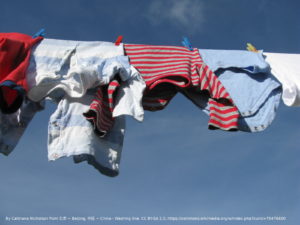 Many parents find that the washing machine is on all the time with small children. This is the case whether you use cloth nappies or not. Soaking mucky clothes before washing means you can wash on a shorter cycle at a cooler temperature.
Many parents find that the washing machine is on all the time with small children. This is the case whether you use cloth nappies or not. Soaking mucky clothes before washing means you can wash on a shorter cycle at a cooler temperature.
If you can dry clothes outside so much the better, but in October in the UK that’s asking a lot. If you have the space a rotary washing line with a rain cover will allow you to dry clothes outside whatever the weather, or at least reduce tumble drying time. The covers aren’t cheap, but are less expensive and co2 emitting than buying and running a tumble dryer. Otherwise a covered outside area or garage with a front and back door open are good spots for clothes horses or lines. Air movement is as effective as heat at drying clothes.
Nappies
One of the big decisions parents face is whether to use cloth nappies. I think it’s fair to say that the jury’s out as to whether it’s worse to use the electricity and water to wash cloth nappies or to manufacture disposables. If your metric is the content of the nappy, so to speak, then cloth wins every time over the gels in disposables. Cloth can be used almost infinite times making them a great second hand buy, fantastic to use for several children, and can then be sold on. Cloth nappies are a science and an art all of their own, so I won’t attempt here to make any recommendations.
Nurseries can be iffy about cloth nappies if they don’t see them often. I found a quick demo sorted out any problems, and that was 10 years ago. Things will have improved since then. Using cloth doesn’t have to mean never using disposables, but it does mean fewer in landfill taking forever to decompose, which has to be a good thing. Nappy washing services exist in many areas, as do nappy libraries. In many areas of the UK council grants are available towards buying a set of cloth nappies, so look around if you are considering them.
Food
Eventually your baby will want real food. To keep your carbon footprint down, provide your baby with home made food. Pouches and jars are easy and quick, but more energy-intensive to produce, package and transport. The same goes for formula milk and all its paraphernalia. If it’s open to you, breastfeeding means less CO2.
Clothes
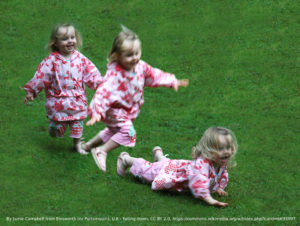 Babies don’t actually care what they wear. Until children are surprisingly old they can go through at least one if not several changes of clothes a day. Spitting up, eating, painting, mud, accidents, falling over, finding your nail varnish and so on, they get in a real mess. Save yourself a bomb and the planet some CO2 by buying a job lot of baby clothes. Accept cast-offs from family and friends. You will never look back and wish you’d spent more on baby clothes.
Babies don’t actually care what they wear. Until children are surprisingly old they can go through at least one if not several changes of clothes a day. Spitting up, eating, painting, mud, accidents, falling over, finding your nail varnish and so on, they get in a real mess. Save yourself a bomb and the planet some CO2 by buying a job lot of baby clothes. Accept cast-offs from family and friends. You will never look back and wish you’d spent more on baby clothes.
Many people sell their children’s clothes in age-range batches on eBay and Facebook, and it’s a great way to buy. I start off buying my daughter, baby no 1, new clothes and kit, but swiftly came round to second hand. By the time my son was on his way and I’d acquired two stepchildren, second hand was the way. I was lucky that my sensible friends had finished having babies and gave me almost everything I needed (and had got rid of a few years before).
Toys
Toys are an area where it’s easy to spend a fortune for little gain. Children are very happy playing with simple toys, and you can add things as they get older. Second hand toys are great. Many toys can be put through the washing machine, washed with soapy water or even sterilised in the microwave. You’ll find children with shedloads of toys often ignore 3/4 of them and play with the same two or three favourite things for a while, then move on to the next favourite items.
Keep toys cycled by donating to charity any you know your children have finished with. Toy libraries exist, and of course there’s the book library. These can be great places to spend time with babies and young children.
But having children doesn’t have to be a hair shirt exercise in frugality. Yes insulating your home and buying used items will save you money and the planet further emissions, but you can view this as saving you money and carbon footprint for the things you know you will really benefit from. You can economise after spending money improving your home. Save money towards your first night out without children, or even the dizzy heights of a weekend away. You might need a bigger car. You might even need a bigger home. Save money and carbon where you can, and spend it where you need to, like in the wine aisle.
Transition Towns
Wikipedia defines transition towns as ” grassroot community projects that aim to increase self-sufficiency to reduce the potential effects of peak oil, climate destruction, and economic instability.” It seems to come down to local community-led environmental change, within a group mindset. The core principle is reducing reliance on fossil fuels and use resources wisely. By networking, transition towns benefit from freely shared experience to create change quickly and inclusively. The economic aspect of this is known as Reconomy. The Transition Network defines a transition-orientated business as:
“They provide essential goods and services for the community in which they make their home, create meaningful, satisfying jobs and buy from other local independent businesses. A Transition Enterprise is a financially viable trading entity that fulfils a real community need, delivers social benefits and has beneficial, or at least neutral, environmental impacts.”
The network would like to see this type of business providing services across a range of sectors including food, transport, energy and housing.
 Global reach
Global reach
Transition is now a worldwide movement. In the Netherlands Bakery De Ondergrondse (the Underground) produces bread to order. It serves co-operative shareholders and occasional external customers. Flour comes from a local windmill. The bakery teaches breadmaking and helps other co-operative bakeries start up.
In Croatia a bike repair project provides the tools, space and expert volunteer help for mending bicycles. As people acquire skills they in turn volunteer their help. This is a great example of the positive and contributing mindset of transition. Canapuglia in Puglia, Italy, has used hemp to great effect. Growing it repairs depleted soils. The end product is used in building, food, medicine, textiles and paper. This small organisation has spread great enthusiasm through the local area at every level. In Belgium a small company provides logistics service by bike. There’s a similar service in Hereford, Pedicargo.
Moving towards Transition
In Meerlanden in the Netherlands a traditional waste disposal company is progressing towards becoming a Transition-minded outfit. Now the compostable wasste they collect is processed into gas, co2, heat, water and compost. They fuel their fleet on the gas and will be making this fuel more widely available. The heat feeds local greenhouses and the water is used for street cleaning. In the springtime, all participants get free compost for the garden. This example shows that traditional businesses can add value to their community without suffering any penalty.
UK

In the UK, transition towns include Lewes in Sussex and Totnes in Devon. Totnes was the first official transition town in the UK. Many towns run activities that fit within the transition definition without formally designating themselves transition towns. Lewes is running a repair cafe, and this happens in Leominster in Herefordshire too, but Leominster doesn’t describe itself as a transition town.
Lewes is looking to work with OVESCO, which describes itself as “a not-for-profit community benefit society”, to fit solar panels on schools in the county. Investors buy shares in the installations. Lewes is making a plastic-free pledge (another measure adopted by many towns not describing themselves as Transition towns) and developing its Neighbourhood Plan on an “ecosystem approach”. An ecosystem approach considers the environment when making planning decisions. It identifies the benefits to residents of the natural world and features around them. Aims include reducing flood risk, energy use and water use, and maximising residents’ access to nature.
If you are in Devon or can get there, Totnes is running Transition Walks. There are four more dates this year, in August, September and October. If you’d like to find out more about what transition is, and how Totnes has benefited and contributed, these walks sound like a great place to start.
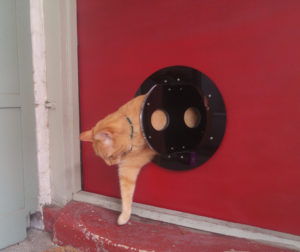 And what are we up to? Well actually we’re working on our own wind turbine design. This is under wraps for the time being. We had a good photoshoot with cats on Friday. Honey and Blackcat were purrrfect models and some of the shots are up on our website and social media.
And what are we up to? Well actually we’re working on our own wind turbine design. This is under wraps for the time being. We had a good photoshoot with cats on Friday. Honey and Blackcat were purrrfect models and some of the shots are up on our website and social media.
Thank you for listening to episode 9 of the Energy Efficiency Podcast, available through Apple Podcasts. Video version os some episodes are available on YouTube – look for the Ecoflap channel where we also have product videos. Until next time you can find us on both Twitter and Instagram as Ecoflap, and on Twitter we also tweet under The Petflap. In next week’s episode we’ll look at hydropower, energy efficiency in tourism and start our look at different insulation materials.
Music credit: “Werq” Kevin MacLeod (incompetech.com)
Licensed under Creative Commons: By Attribution 3.0 License
http://creativecommons.org/licenses/by/3.0/
